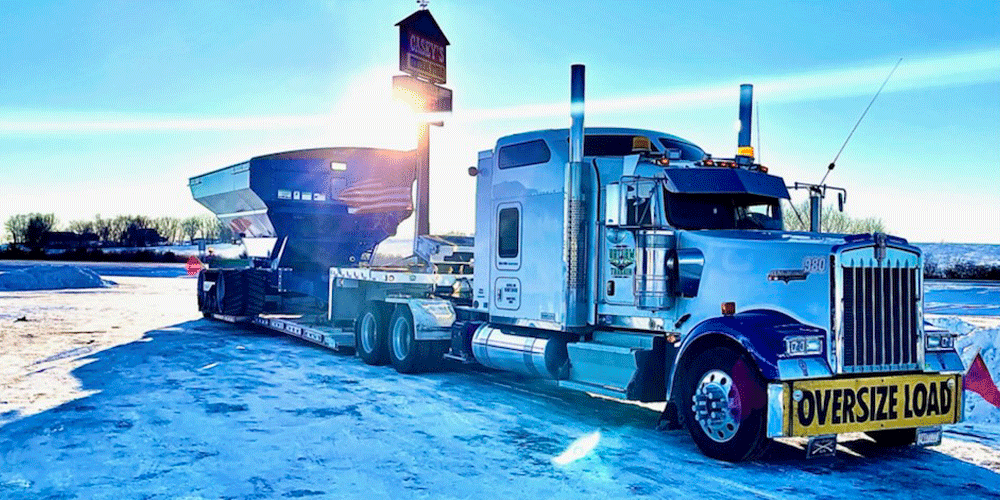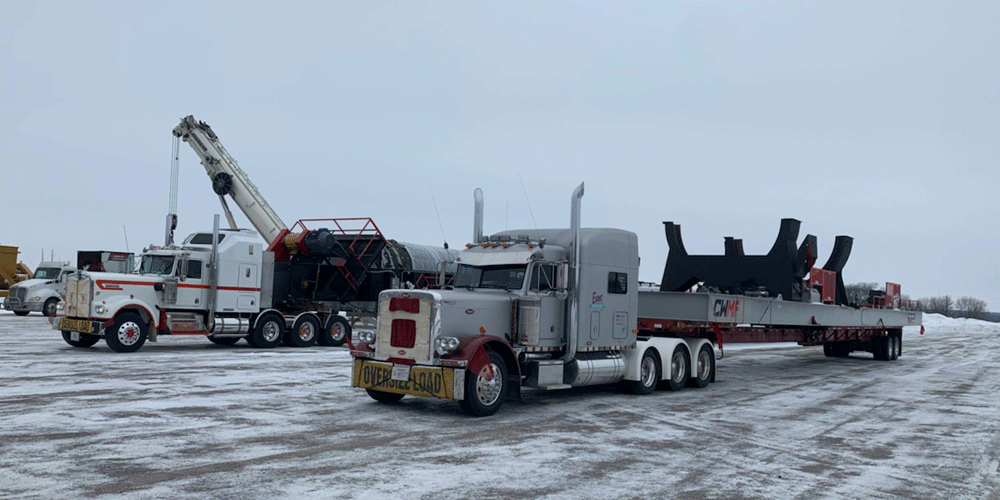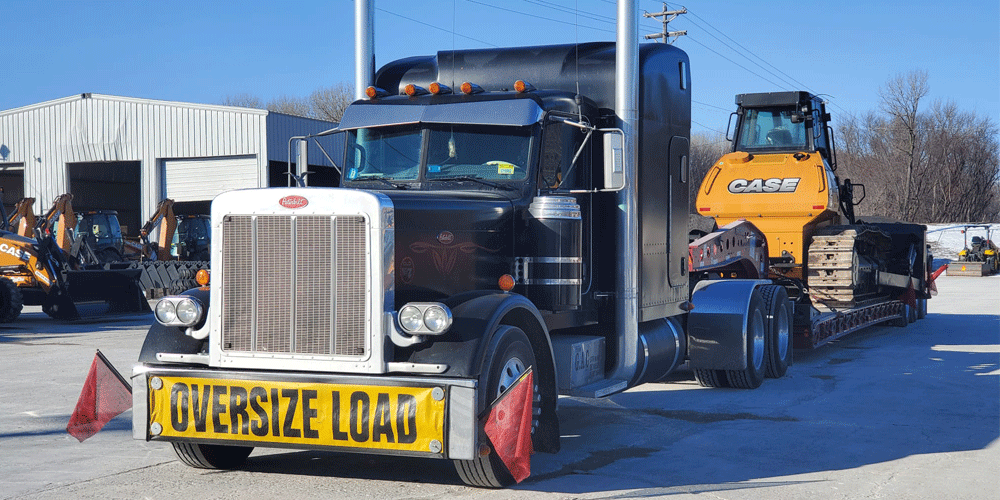Load Securement Tips: Is a Flatbed Trucking Right for Me?
Charlie has been with ATS for nearly two decades. He wears many hats at ATS as the safety instructor for flatbed cargo securement. He takes drivers through flatbed securement training in orientation and is the point person for drivers who have questions on the road. He’s also able to answer any hazmat questions drivers may have.
Do you have what it takes to be a flatbed trucker and secure different types of cargo every day?
Flatbed trucking and load securement can be intimidating. If you were to take your tractor and flatbed trailer and turn them upside down and shake them, would your load still be secure?
That’s the goal with cargo securement — your load should be so secure that nothing is going to make it come loose.
Flatbed trucking can be intense. Throwing heavy chains over a load can be a tough, labor-intensive job. It’s certainly not for everybody. But, undergoing load securement training can be the start of a rewarding flatbed trucking path for you.
Perhaps you’re worried about the math involved. Maybe you don’t know if you’ll quite understand the Department of Transportation (DOT) cargo securement rules. Maybe you’re simply scared that you won’t secure a load properly and you’ll lose part of it going down the road.
Or maybe, it’s something else entirely. Maybe you think that receiving securement training and transitioning into the flatbed division involves working with a trainer again and you’d rather do anything but drive with a trainer again. (Plot twist: You don’t have to drive with a trainer again to transition into the flatbed division.)
You aren’t alone if you’re feeling this way. Countless drivers have stood in your shoes, trying to decide if undergoing flatbed securement training and becoming a flatbed driver is worth it or if they’d rather continue driving a dry van truck.
Here at Anderson Trucking Service (ATS), I take drivers through load securement training every week. I facilitate a thorough training program that takes drivers like you through a written test and a hands-on test. Drivers have a chance to talk through all their questions so they feel comfortable getting out on the road and securing their first load.
I’m going to explain cargo securement and the securement training process to you so you know what’ll be expected of you and you can decide if becoming a flatbed driver is right for you.
This article will teach you:
- What a good load securement training program looks like.
- What’s covered in load securement training.
- How to decide if flatbed trucking is right for you.
When you’re done reading, you’ll feel far less confused and intimidated by securement training. You’ll know if flatbed trucking is the right next step for you.
What Happens During Load Securement Training?
Not all load securement training programs are created equal. Some programs are not as thorough as others. That’s why it’s important for you to vet trucking carriers before you sign on with them to ensure you get the training you need to secure various cargo on different types of trailers.
The securement training you got in trucking school was probably brief or nonexistent, so it’s important for you to pursue additional training to feel comfortable securing a variety of flatbed loads.
Classroom Training
Securement training will typically start with training in the classroom.
First and foremost, you’ll learn about the DOT cargo securement requirements. These rules are in place to prevent a load from shifting or falling off your trailer and causing an accident. Your trainer will cover the importance of proper securement and what can happen if a load isn’t properly secured.
You’ll be introduced to tie-downs like chains, straps and binders. Each cargo securement tie-down has a working load limit (WLL). The tie-downs need to be rated high enough to support and secure the weight and length of the load.
This is where the math comes in, but it’s really not nearly as difficult as it seems. All you need need to know is the total weight of your load and make sure you’re putting enough securements on the load to support and secure that weight. To calculate minimums to ensure you’re legal, divide the total weight by the weight rating of the tie-downs. See? Simple math.
For instance, if the load is 20,000 pounds and each strap is rated for 5,500 pounds, simple math will tell you that you need four straps to secure the load.
It’s always best to over-secure rather than under-secure. You should never under-secure your loads. You should never guess how many cargo securement tie-downs you need; it’s not worth the risk.
Not only will you learn about how many securement tie-downs you’ll need based on weight, but you’ll also learn about where those tie-downs need to be placed on the load per DOT regulations. Training will also cover cargo securement tips and best practices. You’ll learn what type of securement tie-downs you should use for different types of loads.
Before the classroom portion is finished, you may need to complete and pass a written test to ensure you understand what you’ve learned in class. Take the opportunity to discuss any lingering questions you may have about securement training. It’s a lot to take in and no question is a stupid question. Make sure you feel prepared to get on the road and secure your loads.
Related: The Pros and Cons of the ATS Flatbed Program
Hands-On Load Securement Training
After classroom training, you’ll receive hands-on training. You’ll not only get the chance to practice securing different types of loads with different tie-downs, but you’ll also be introduced to different types of trailers. You’ll also learn more about tarping.
During this portion of training, you’ll get the chance to see different types of loads and how they’re secured. If you’ve never touched a tarp, a chain or a height stick, you’ll become very familiar with them during training.
You’ll also learn helpful tips and tricks to help you succeed on the road — no matter what you’re hauling. From how to properly carry a chain so you don’t hurt your back, to throwing a strap over a load the right way, to avoiding securing the load too tightly and damaging the equipment, you’ll be loaded with information by the time training is complete.
Just like with the classroom portion of training, you’ll be tested on your securements.
During this portion of training, you'll get a good feel for whether or not flatbed trucking is right for you. You may decide while you're practicing load securements that you hate it and would rather stick with hauling van trailers.
Should I Pursue Flatbed Trucking?
The number thing you need to consider when pursuing flatbed training is desire. Do you have the desire to haul a flatbed trailer? Do you enjoy the thought of hard, physical labor? Are you prepared to tarp and secure loads outside no matter the weather conditions?
Flatbed driving and securing your loads isn’t a walk in the park; if this isn’t something you can see yourself doing five or ten years down the road, going through cargo securement training might not be worth it for you.
Flatbedding is hard work, but it can be very rewarding if it’s something that truly excites you. Every day is different and every day is challenging.
When you haul flatbed loads, you open yourself up to a world of possibility. If you want to be a heavy haul driver one day, this is the first step to get you there. You’ll have the same scene in your rearview mirror as a dry van driver on day one and day 10,000. As a flatbed driver, what’s behind you is always changing.
Keep in mind that some companies specialize in only one type of freight, while other companies haul a wide variety of freight. With one company, you may only be hauling pipes or construction materials. At another company, you may have to secure a different type of load every day — from construction equipment to crane booms, farming equipment and more.
If you’re curious about flatbed training and you want to dip your toes in, starting with a company that only hauls one type of freight is a great option. You’ll have the opportunity to get really good at securing that one type of freight. Then, once you’re ready, you can move up and go to a company with more specialized loads where you’ll have the chance to flex your securement skills.
Dry Van vs. Flatbed Trucking: Making Your Decision
Load securement training can feel very complex. But once the concepts are broken down and simplified, it’s easy to understand. Simplicity leads to understanding and understanding leads to compliance.
If you know how to calculate a budget and determine how many payments you’ll need to make to pay off a loan, you can calculate securement minimums.
Make sure that you do your research on the company before you pursue securement training. You want a company that has a comprehensive securement training program and will provide you the support you need to succeed. For instance, ATS has a driver app full of great securement information and we have a photo program in which drivers can send us photos of their securements and ask questions about them.
I want to make sure you’re as prepared as possible to start your flatbed journey. To help make that decision easier on you, we’ve put together a blog that explains the differences between being a flatbed driver and a dry van driver.
If you’re ready to jump right into flatbedding, the ATS company flatbed program might be just what you’re looking for. Learn more about the pros and cons of the program.




